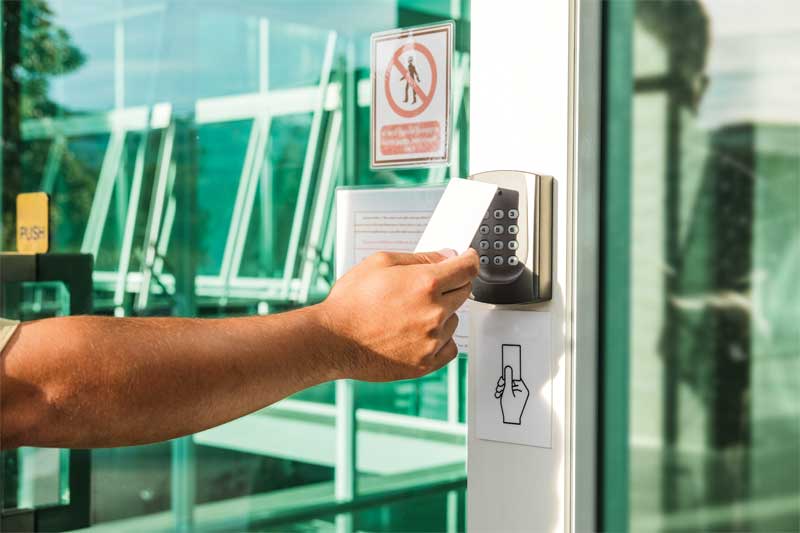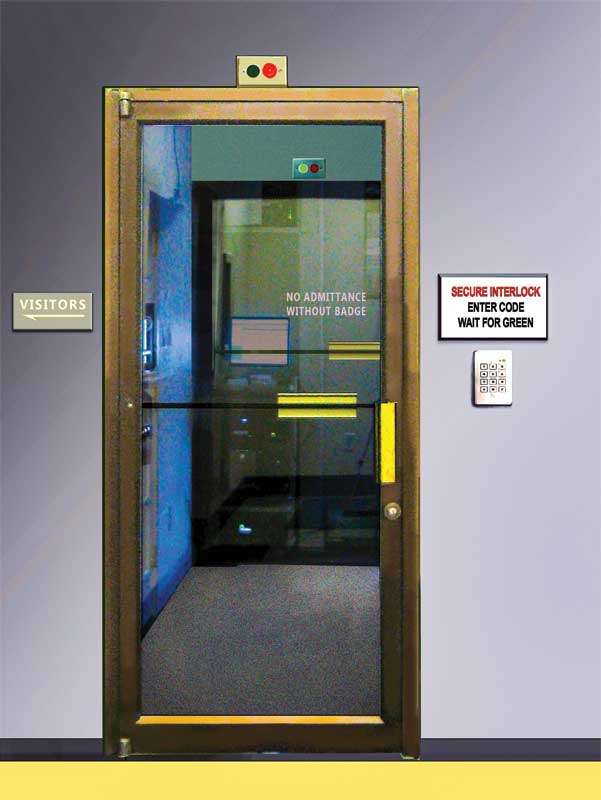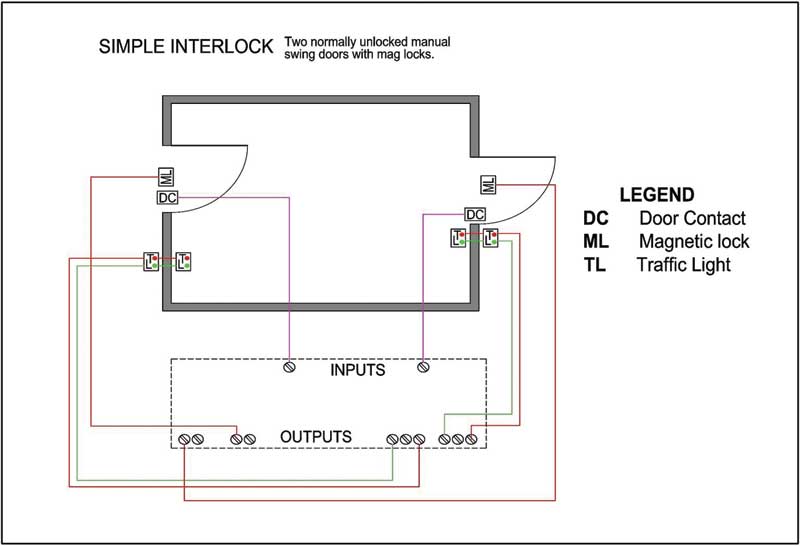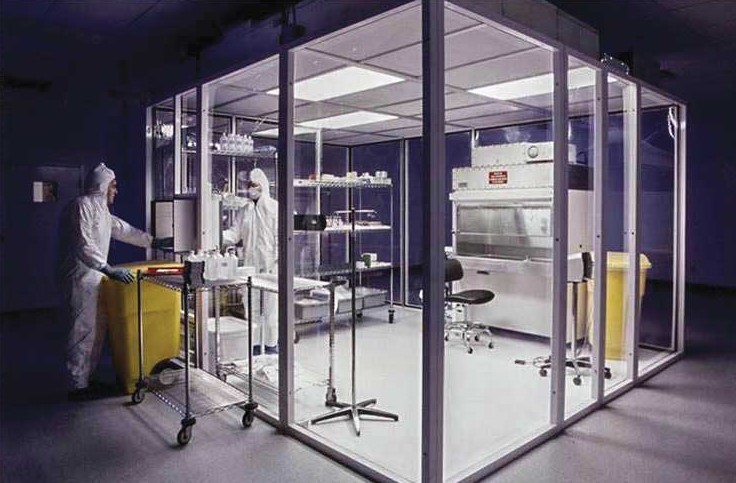Best practices for selecting and installing door interlock technology
by Sarah Said | September 13, 2018 11:41 am
by Bryan Sanderford
 [1]
[1]Choosing a door control system for a facility is of the utmost importance to ensure the safety and security of people, property, and assets. Owners and designers need to select a system that is appropriate based on the flow of people, the type of assets held within the facility, and current and future security threats.
Doors are usually thought of as a means of keeping someone out, or alternately, keeping someone in. Doors provide privacy and, when locked, a level of security that is both simple and effective. There are many ways doors can be opened or closed. They can be manually operated with a handle or push bar, revolve, swing, or even slide into a pocket in the wall. They can be operated automatically with the push of a button, the swipe of a card, or a proximity device, or be programmed to lock if another door is open or unsecure.
There are more options for door technology on the market than ever before, including advanced programmable door interlock systems (often called mantraps), which provide very high levels of security. By gaining a better understanding of how different door interlock systems work, designers and specifiers can select the most appropriate configuration for a given project.
There are numerous applications for interlock systems spanning a variety of industries. Some of the most prevalent users include:
- casinos, in areas where cash is handled;
- armored car facilities, to control vehicle entry;
- prisons and police stations, for transporting detainees;
- medical facilities, for patient transport and deliveries;
- secure government facilities, such as federal reserves and military R&D installations;
- sensitive compartmented information facilities (SCIF) where sensitive information and conversations take place;
- high risk wholesale and retail establishments where expensive merchandise, such as jewelry, is exchanged;
- check cashing facilities, to monitor individuals entering areas where cash transactions take place;
- schools where access areas require added security; and
- laboratory and pharmaceutical facilities where clean rooms are deployed.
Door interlock systems provide a form of protection not afforded by conventional access control systems, which, typically, can be more easily compromised due to their connection to a networked computer susceptible to hacking.
In its simplest form, a door interlock system is composed of two doors electronically connected so one cannot open until the other has closed. A good way to visualize the technology is by picturing an entryway with a door at either end. Using some form of access control device, a user is granted access through the first door to enter the hallway. Once the first door is closed, the second door can then be opened automatically or triggered by an operator, allowing the user to pass through the second door. Such simple applications are often used in applications like inner city jewelry stores where an employee grants initial access to a visitor, and then visually screens them before allowing entry into the sales area. This same basic door interlocking set-up has countless applications across many different industries.
Office complexes and industrial facilities are increasingly employing door interlock systems as they represent a very reliable and secure means of managing both pedestrian and vehicular traffic. There are several important criteria to consider when choosing a door interlocking system, based on the type of facility and the specific application. The parameters for each installation vary greatly depending on the client’s specific security objectives. Typically, a design consultant or systems integrator is tasked with working out the design and installation specifics.
 [2]
[2]Photos courtesy Dortronics Systems Inc.
Airlock control system
This is a low-security system used only for environmental control. Operation is simple: all doors are normally unlocked, and opening any door will lock the related doors so only one door in a designated area can be accessed at a time. This provides easy ingress or egress to an area without destabilizing the environment of the adjoining areas, whether these are interior rooms or the exterior of the building. Airlock control systems are the least secure type of door interlocking system since all of the doors are always open, and two or more doors can actually be opened simultaneously. Since these are not for security, airlocks typically use red and green lights as a visual indication to control traffic. If the airlock is in a biological-type lab setting where control of airborne pathogens is required, locks are utilized on the doors to ensure air quality is maintained.
Secure entry/free egress
A secure entry/free egress system provides a more secure entrance solution and will allow a faster method of egress through a combination of locked and unlocked doors. Exterior doors are normally secured and interior doors normally unlocked. An electronic access system controls entry from the exterior and a request-to-exit (REX) device is used on the interior of the outside door.
With this system, a valid access card will unlock the exterior door only if the interior door is closed. Unlocking the exterior door will lock the interior door. Once the exterior door is re-secured, the interior door is unlocked to allow access into the facility. In addition, opening the interior door prevents the exterior door from being unlocked.
From a practical perspective, envision an entryway into an apartment building. An access card or code entered into a keypad unlocks the exterior door allowing entry into a vestibule. Once the exterior door is closed and automatically locks, the interior door can be opened using the same credentials, or by having the individual buzzed by the resident. If the interior door remains locked, the individual in the vestibule can exit the exterior door enabling “free egress.” This type of system allows a faster egress since the interior door is already in an unlocked state and the exterior door only requires a push on the REX button to unlock.
Restricted entry and exit system
The highest level of security is provided with a restricted entry and exit system, whereby a door is unlocked by a request for access only if no other related doors are unsecured. Opening any one door keeps all other related doors locked. Restricted entry and exit systems will buffer simultaneous requests for access to prevent two or more doors from being unlocked.
 [3]
[3]Specific uses
Choosing a door interlock system will greatly depend on the facility’s specific environment. For example, banks and other financial institutions require a higher level of security than most commercial sites as a result of the greater risk associated with the sensitive nature of their business and the value of the assets on their premises. Traditionally, these organizations rely on card access and video surveillance systems to provide a heightened level of security, but it is becoming more common for them to also incorporate multiple door interlock systems.
Paired with a metal detector, an interlock system could provide the ability to automatically lock doors, preventing visitor access, if a possible concealed firearm is detected. In this type of application, an interlock door system provides unrestricted access to the interior vestibule, where customers then pass through a metal detector before entering the inner lobby through a locked door. Access to the interior is only allowed when the exterior door is closed, and no metal is detected. If both conditions are met, the exterior door is locked, and the visitor is allowed to enter through the interior door. Should the visitor be deemed suspicious, an alert sounds, and the individual is denied entry to the lobby and may only exit to the street.
Door interlock systems are also commonly used in cleanrooms. Unfortunately, many cleanrooms cannot be easily expanded or reconfigured, while remaining in compliance with the mandatory industry standards. Many modular cleanrooms are not supplied with door interlocks and must be retrofitted in the field. As a result, cleanroom manufacturers benefit from utilizing door interlock controls as an option for new and existing installations as a means of addressing these changing conditions.
The addition of door interlocks not only assures the cleanroom meets the necessary International Organization for Standardization (ISO) classifications by enforcing clean air control, but can also add a level of security within the controlled environment of the cleanrooms.
 [4]
[4]Choosing a system
A best practice is to first evaluate a facility’s security and/or environment control objectives to help determine the level of door interlock solution required. For example, data centers typically require a higher level of security than general office buildings, as specific security restrictions, such as entering a facility with portable memory devices, would not pertain. Door interlock systems for clean rooms may entail numerous sensors to monitor air pressure or temperature before granting access.
Door interlocks are also available with different modes of functionality. An office building with a high amount of pedestrian traffic in the morning and late afternoon may want two doors operating during these periods with the flexibility to switch to a single door during midday hours.
Many door interlocking systems also include intercom communications between the person(s) inside the “mantrap” and a security guard or operator. Advanced configurations are also deployed with biometrics that read faces, eyes, or fingerprints to provide accurate identity verification, adding a much higher level of sophistication and security.
In many instances, the door interlock system must also be discreet and user friendly, or it can become a logjam for pedestrian traffic. A system should allow users to pass through with little effort and in comfort. Working with a reputable manufacturer with in-house capabilities can help ensure the project achieves its goals for ease of operation and specific door interlock capabilities.
With their high degree of programmable operations, door interlock systems are often subject to specific building code requirements. Some municipalities may not allow any doors in a public facility to be locked at any time. While this scenario is intended to provide personnel safety, door violations can become a common occurrence and even a hazard. In some instances, this has been addressed with the use of red/green traffic lights mounted on either side of the doors to indicate when access is allowed. Adding a built-in sounder which annunciates a door violation can minimize access violations.
In an emergency, the door interlock system must also enable people to evacuate the facility. For example, if the power fails, an emergency override handle would ensure the door can be opened manually. Further, life safety codes may require that the door interlock systems be integrated with the facility’s fire alarm control panel to allow emergency door release. A local emergency pull station may be required to allow doors to be unlocked in non-fire alarm emergencies or to interface the system with the National Fire Protection Association (NFPA) 101, Life Safety Code, delayed egress controls.
Installation guidelines
Local building inspectors should always be consulted before installation of a door interlock locking system to help ensure compliance. There are situations where any locks restricting an exit are simply not permitted. In these systems, only traffic lights may be deployed to indicate when entry or exit is permitted. The traffic lights are a visual indication to control traffic; often a buzzer is integrated into the system to audibly warn if there
is a traffic light violation.
Selecting the proper interlock controller
Another consideration when choosing a door interlock system is the interlock controller. The number of doors, types of doors, and other monitored and/or controlled devices all play into the equation when evaluating an interlock controller.
While totally independent interlocking doors can be controlled from a single PLC controller, the distance separating the doors can limit the number of doors per controller. This can complicate the design and deployment of a door control system. Inputs to be monitored by the controller must also be accessed. Monitored devices and operations should include door status, latch monitor, maglock bond sensor, the request-for-access device, card access lock relay, and local push button or other REX device. Doors which are normally unlocked require only a door position switch. Other monitored devices could include emergency override stations and tailgate detectors. All inputs must be dedicated dry contacts, not shared with other systems, and if required, input devices can be mirrored with PLC relay outputs.
Outputs (relays and powered outputs) can be used to operate the electric locking devices, indicator lights, and alarm sounders, and to signal other systems (card access, guard station consoles, etc.). At least one output relay is required for each controlled door to operate the electric lock. The lock relay contacts can also be used to signal door access status. If the doors are normally unlocked, indicators should follow the lock status (i.e. red = locked/green = unlocked). When doors are normally locked, most systems utilize traffic lights to indicate when access may be inhibited (red = access not allowed/green = available for access) as doors may be locked awaiting authorization from the card access system or when the door is not currently available for access because another door is in use.
There are numerous commercial and industrial access applications for door interlock systems, ranging from systems with as few as two doors to systems with several doors, as well as highly specialized vehicular applications, such as armored cars or prison carriers. In many cases, door interlock systems provide a highly efficient and effective solution for myriad security and environmental control applications.
Bryan Sanderford is the national sales manager for Dortronics Systems Inc. Sanderford has extensive hands-on experience with access control products. Prior to joining Dortronics in 1998, Sanderford had 10 years of experience as an installing dealer of access control systems, coupled with nine years as an independent sales representative of security products. He has played an instrumental role in driving the development of numerous electronic locking systems products and technologies marketed under the Dortronics brand name. Sanderford has been active in the access control and security industry since 1977. He is a longstanding member of the Security Industry Association (SIA). He can be reached at bryan@dortronics.com[5].
- [Image]: https://www.constructionspecifier.com/wp-content/uploads/2018/09/bigstock-206839522.jpg
- [Image]: https://www.constructionspecifier.com/wp-content/uploads/2018/09/Dortronics_2-door-Interlock.jpg
- [Image]: https://www.constructionspecifier.com/wp-content/uploads/2018/09/Dortronics_Simple-Interlock-Graph.jpg
- [Image]: https://www.constructionspecifier.com/wp-content/uploads/2018/09/Dortronics_Cleanroom-1.jpg
- bryan@dortronics.com: mailto:bryan@dortronics.com
Source URL: https://www.constructionspecifier.com/best-practices-for-selecting-and-installing-door-interlock-technology/